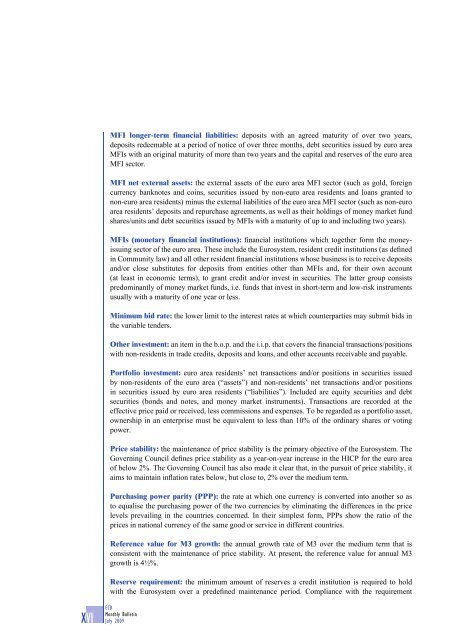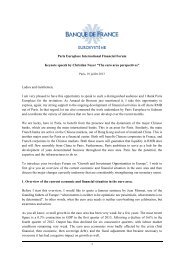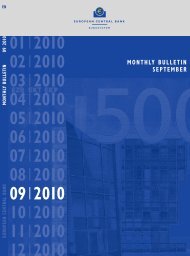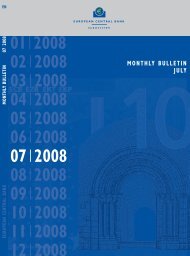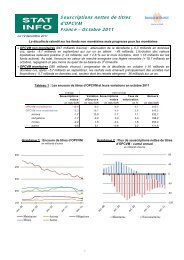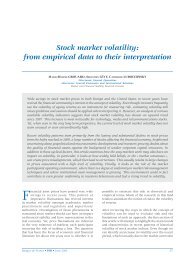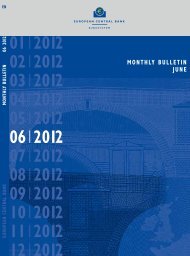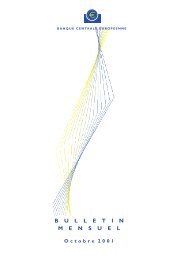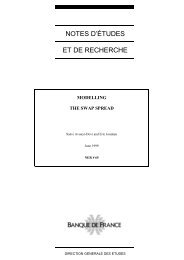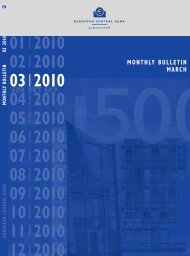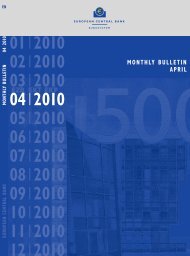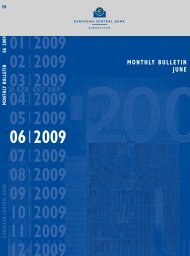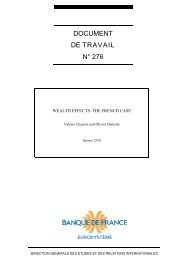Monthly Bulletin July 2009 - Banque de France
Monthly Bulletin July 2009 - Banque de France
Monthly Bulletin July 2009 - Banque de France
Create successful ePaper yourself
Turn your PDF publications into a flip-book with our unique Google optimized e-Paper software.
MFI longer-term financial liabilities: <strong>de</strong>posits with an agreed maturity of over two years,<br />
<strong>de</strong>posits re<strong>de</strong>emable at a period of notice of over three months, <strong>de</strong>bt securities issued by euro area<br />
MFIs with an original maturity of more than two years and the capital and reserves of the euro area<br />
MFI sector.<br />
MFI net external assets: the external assets of the euro area MFI sector (such as gold, foreign<br />
currency banknotes and coins, securities issued by non-euro area resi<strong>de</strong>nts and loans granted to<br />
non-euro area resi<strong>de</strong>nts) minus the external liabilities of the euro area MFI sector (such as non-euro<br />
area resi<strong>de</strong>nts’ <strong>de</strong>posits and repurchase agreements, as well as their holdings of money market fund<br />
shares/units and <strong>de</strong>bt securities issued by MFIs with a maturity of up to and including two years).<br />
MFIs (monetary financial institutions): financial institutions which together form the moneyissuing<br />
sector of the euro area. These inclu<strong>de</strong> the Eurosystem, resi<strong>de</strong>nt credit institutions (as <strong>de</strong>fined<br />
in Community law) and all other resi<strong>de</strong>nt financial institutions whose business is to receive <strong>de</strong>posits<br />
and/or close substitutes for <strong>de</strong>posits from entities other than MFIs and, for their own account<br />
(at least in economic terms), to grant credit and/or invest in securities. The latter group consists<br />
predominantly of money market funds, i.e. funds that invest in short-term and low-risk instruments<br />
usually with a maturity of one year or less.<br />
Minimum bid rate: the lower limit to the interest rates at which counterparties may submit bids in<br />
the variable ten<strong>de</strong>rs.<br />
Other investment: an item in the b.o.p. and the i.i.p. that covers the financial transactions/positions<br />
with non-resi<strong>de</strong>nts in tra<strong>de</strong> credits, <strong>de</strong>posits and loans, and other accounts receivable and payable.<br />
Portfolio investment: euro area resi<strong>de</strong>nts’ net transactions and/or positions in securities issued<br />
by non-resi<strong>de</strong>nts of the euro area (“assets”) and non-resi<strong>de</strong>nts’ net transactions and/or positions<br />
in securities issued by euro area resi<strong>de</strong>nts (“liabilities”). Inclu<strong>de</strong>d are equity securities and <strong>de</strong>bt<br />
securities (bonds and notes, and money market instruments). Transactions are recor<strong>de</strong>d at the<br />
effective price paid or received, less commissions and expenses. To be regar<strong>de</strong>d as a portfolio asset,<br />
ownership in an enterprise must be equivalent to less than 10% of the ordinary shares or voting<br />
power.<br />
Price stability: the maintenance of price stability is the primary objective of the Eurosystem. The<br />
Governing Council <strong>de</strong>fines price stability as a year-on-year increase in the HICP for the euro area<br />
of below 2%. The Governing Council has also ma<strong>de</strong> it clear that, in the pursuit of price stability, it<br />
aims to maintain inflation rates below, but close to, 2% over the medium term.<br />
Purchasing power parity (PPP): the rate at which one currency is converted into another so as<br />
to equalise the purchasing power of the two currencies by eliminating the differences in the price<br />
levels prevailing in the countries concerned. In their simplest form, PPPs show the ratio of the<br />
prices in national currency of the same good or service in different countries.<br />
Reference value for M3 growth: the annual growth rate of M3 over the medium term that is<br />
consistent with the maintenance of price stability. At present, the reference value for annual M3<br />
growth is 4½%.<br />
Reserve requirement: the minimum amount of reserves a credit institution is required to hold<br />
with the Eurosystem over a pre<strong>de</strong>fined maintenance period. Compliance with the requirement<br />
XVI<br />
ECB<br />
<strong>Monthly</strong> <strong>Bulletin</strong><br />
<strong>July</strong> <strong>2009</strong>


